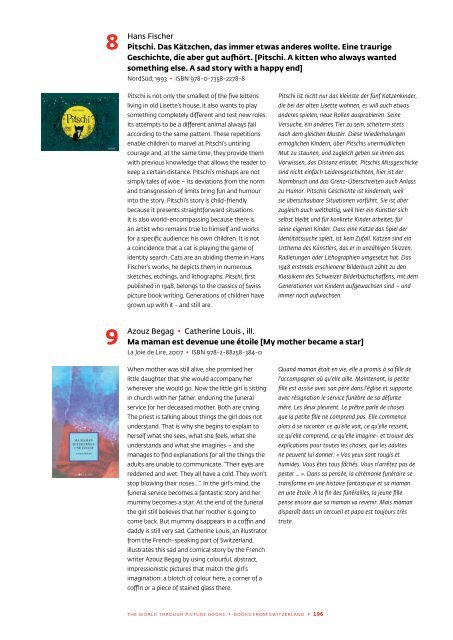world_pictures
world_pictures
world_pictures
Create successful ePaper yourself
Turn your PDF publications into a flip-book with our unique Google optimized e-Paper software.
8<br />
Hans Fischer<br />
Pitschi. Das Kätzchen, das immer etwas anderes wollte. Eine traurige<br />
Geschichte, die aber gut aufhört. [Pitschi. A kitten who always wanted<br />
something else. A sad story with a happy end]<br />
NordSüd, 1993 • ISBN 978-0-7358-2278-8<br />
Pitschi is not only the smallest of the five kittens<br />
living in old Lisette’s house, it also wants to play<br />
something completely different and test new roles.<br />
Its attempts to be a different animal always fail<br />
according to the same pattern. These repetitions<br />
enable children to marvel at Pitschi’s untiring<br />
courage and, at the same time, they provide them<br />
with previous knowledge that allows the reader to<br />
keep a certain distance. Pitschi’s mishaps are not<br />
simply tales of woe – its deviations from the norm<br />
and transgression of limits bring fun and humour<br />
into the story. Pitschi’s story is child-friendly<br />
because it presents straightforward situations.<br />
It is also <strong>world</strong>-encompassing because there is<br />
an artist who remains true to himself and works<br />
for a specific audience: his own children. It is not<br />
a coincidence that a cat is playing the game of<br />
identity search. Cats are an abiding theme in Hans<br />
Fischer’s works, he depicts them in numerous<br />
sketches, etchings, and lithographs. Pitschi, first<br />
published in 1948, belongs to the classics of Swiss<br />
picture book writing. Generations of children have<br />
grown up with it - and still are.<br />
Pitschi ist nicht nur das kleinste der fünf Katzenkinder,<br />
die bei der alten Lisette wohnen, es will auch etwas<br />
anderes spielen, neue Rollen ausprobieren. Seine<br />
Versuche, ein anderes Tier zu sein, scheitern stets<br />
nach dem gleichen Muster. Diese Wiederholungen<br />
ermöglichen Kindern, über Pitschis unermüdlichen<br />
Mut zu staunen, und zugleich geben sie ihnen das<br />
Vorwissen, das Distanz erlaubt. Pitschis Missgeschicke<br />
sind nicht einfach Leidensgeschichten, hier ist der<br />
Normbruch und das Grenz-Überschreiten auch Anlass<br />
zu Humor. Pitschis Geschichte ist kindernah, weil<br />
sie überschaubare Situationen vorführt. Sie ist aber<br />
zugleich auch welthaltig, weil hier ein Künstler sich<br />
selbst bleibt und für konkrete Kinder arbeitet, für<br />
seine eigenen Kinder. Dass eine Katze das Spiel der<br />
Identitätssuche spielt, ist kein Zufall. Katzen sind ein<br />
Urthema des Künstlers, das er in unzähligen Skizzen,<br />
Radierungen oder Lithographien umgesetzt hat. Das<br />
1948 erstmals erschienene Bilderbuch zählt zu den<br />
Klassikern des Schweizer Bilderbuchschaffens, mit dem<br />
Generationen von Kindern aufgewachsen sind – und<br />
immer noch aufwachsen.<br />
9<br />
Azouz Begag • Catherine Louis , ill.<br />
Ma maman est devenue une étoile [My mother became a star]<br />
La Joie de Lire, 2007 • ISBN 978-2-88258-384-0<br />
When mother was still alive, she promised her<br />
little daughter that she would accompany her<br />
wherever she would go. Now the little girl is sitting<br />
in church with her father, enduring the funeral<br />
service for her deceased mother. Both are crying.<br />
The priest is talking about things the girl does not<br />
understand. That is why she begins to explain to<br />
herself what she sees, what she feels, what she<br />
understands and what she imagines – and she<br />
manages to find explanations for all the things the<br />
adults are unable to communicate. “Their eyes are<br />
reddened and wet. They all have a cold. They won’t<br />
stop blowing their noses…“. In the girl’s mind, the<br />
funeral service becomes a fantastic story and her<br />
mummy becomes a star. At the end of the funeral<br />
the girl still believes that her mother is going to<br />
come back. But mummy disappears in a coffin and<br />
daddy is still very sad. Catherine Louis, an illustrator<br />
from the French-speaking part of Switzerland,<br />
illustrates this sad and comical story by the French<br />
writer Azouz Begag by using colourful, abstract,<br />
impressionistic <strong>pictures</strong> that match the girl’s<br />
imagination: a blotch of colour here, a corner of a<br />
coffin or a piece of stained glass there.<br />
Quand maman était en vie, elle a promis à sa fille de<br />
l’accompagner où qu’elle aille. Maintenant, la petite<br />
fille est assise avec son père dans l’église et supporte<br />
avec résignation le service funèbre de sa défunte<br />
mère. Les deux pleurent. Le prêtre parle de choses<br />
que la petite fille ne comprend pas. Elle commence<br />
alors à se raconter ce qu’elle voit, ce qu’elle ressent,<br />
ce qu’elle comprend, ce qu’elle imagine- et trouve des<br />
explications pour toutes les choses, que les adultes<br />
ne peuvent lui donner: « Vos yeux sont rougis et<br />
humides. Vous êtes tous fâchés. Vous n’arrêtez pas de<br />
pester … ». Dans sa pensée, la cérémonie funéraire se<br />
transforme en une histoire fantastique et sa maman<br />
en une étoile. À la fin des funérailles, la jeune fille<br />
pense encore que sa maman va revenir. Mais maman<br />
disparaît dans un cercueil et papa est toujours très<br />
triste.<br />
the <strong>world</strong> through picture books • books from switzerland • 196


